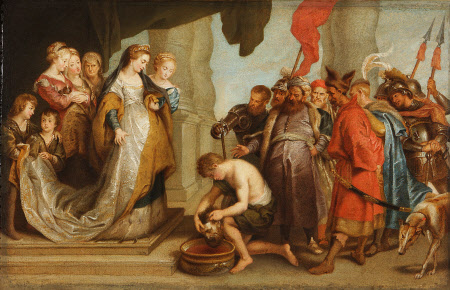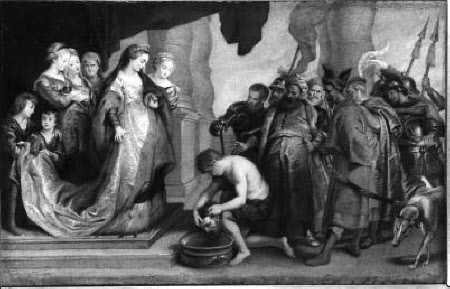Queen Tomyris and the Head of Cyrus
after Sir Peter Paul Rubens (Siegen 1577 - Antwerp 1640)
Category
Art / Oil paintings
Date
1800 - 1899
Materials
Oil on paper laid down on canvas
Measurements
381 x 597 mm (15 x 23 1/2 in)
Place of origin
Flanders (Belgium from 1830)
Order this imageCollection
Attingham Park, Shropshire
NT 608960
Caption
This is a version after the original, which is now in the Museum of Fine Arts, Boston, which was painted around 1618. The scene depicts an episode from the classical historian, Herodotus. Tomyris’s army was led by her son, who was tricked by Cyrus into participating in a great feast, which enabled him to slaughter many of the soldiers. Tomyris’s son killed himself in shame, an act which his mother swore to revenge. In the ensuing battle Cyrus was killed, and in this picture we see his severed head being dipped in an urn of human blood by a servant. Depictions of this scene were chosen because they were seen to be symbolic of justice.
Summary
Oil painting on paper laid down on canvas. Queen Tomyris and the Head of Cyrus (Head of Cyrus brought to Queen Tomyris), after Peter Paul Rubens (Siegen 1577 – Antwerp 1640), 19th century. The gruesome subject is Queen Tomyris's revenge on Cyrus the Great of Persia for having defeated her son by trickery and causing him to commit suicide. The Queen stands to the left looking at the head held over a bowl of blood. This is a late copy of the picture which was formerly in the collection of Lord Darnley and is now at the Museum of Fine Arts, Boston. There is a possibility that there may once have been a large version of the subject at Attingham. The evidence for this is the purchase price of £100 and the sentence in a letter of 8 May 1824 from William Hill to his brother Lord Berwick to the effect that in Woodburn's opinion the Rubens is better than Lord Darnley's.
Provenance
Attingham collection; bequeathed to the National Trust with the estate, house and contents of Attingham by Thomas Henry Noel-Hill, 8th Baron Berwick (1877-1947) on 15th May 1953.
Credit line
Attingham Park, The Berwick Collection (National Trust)
Marks and inscriptions
16 (on frame)
Makers and roles
after Sir Peter Paul Rubens (Siegen 1577 - Antwerp 1640), artist

